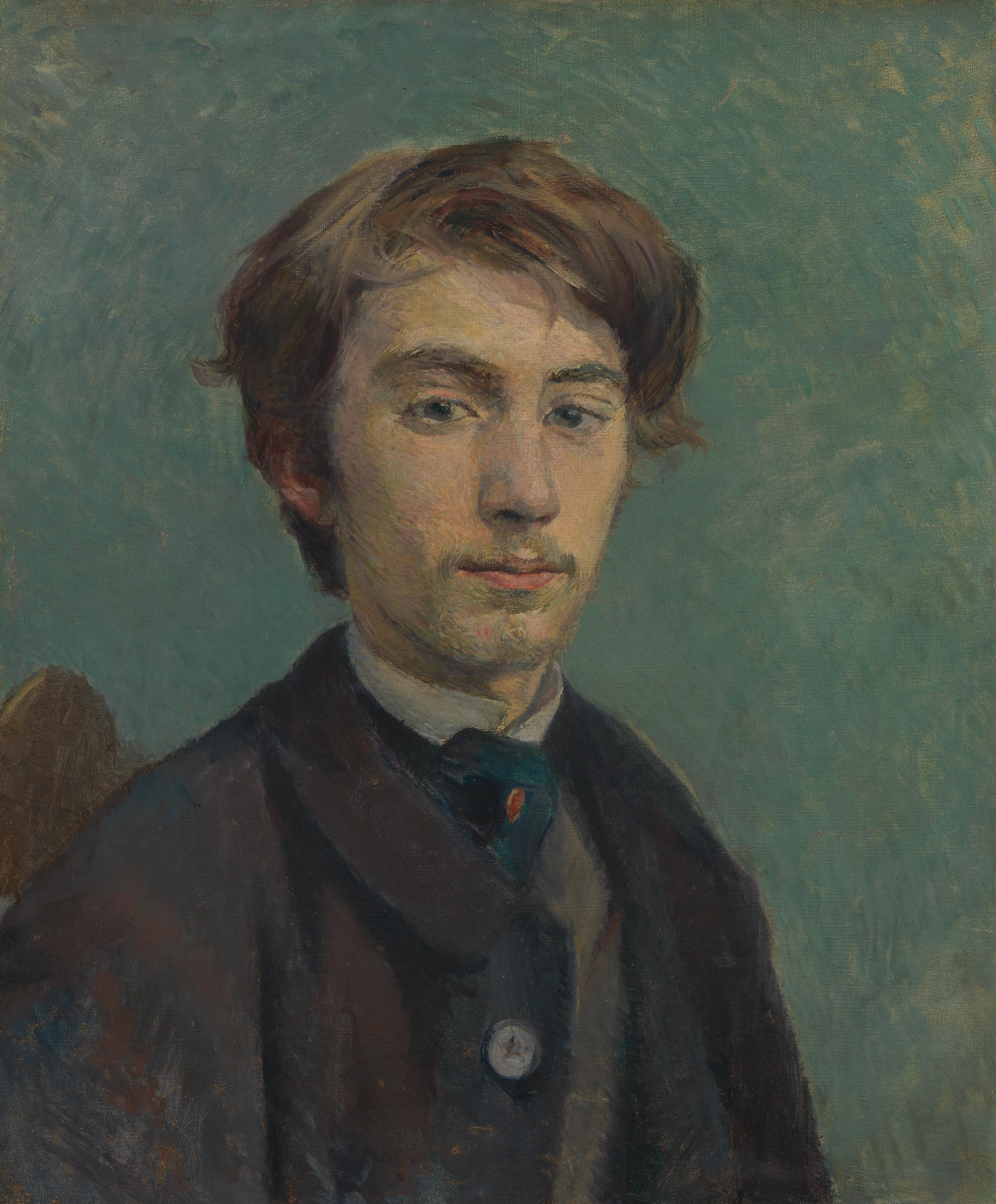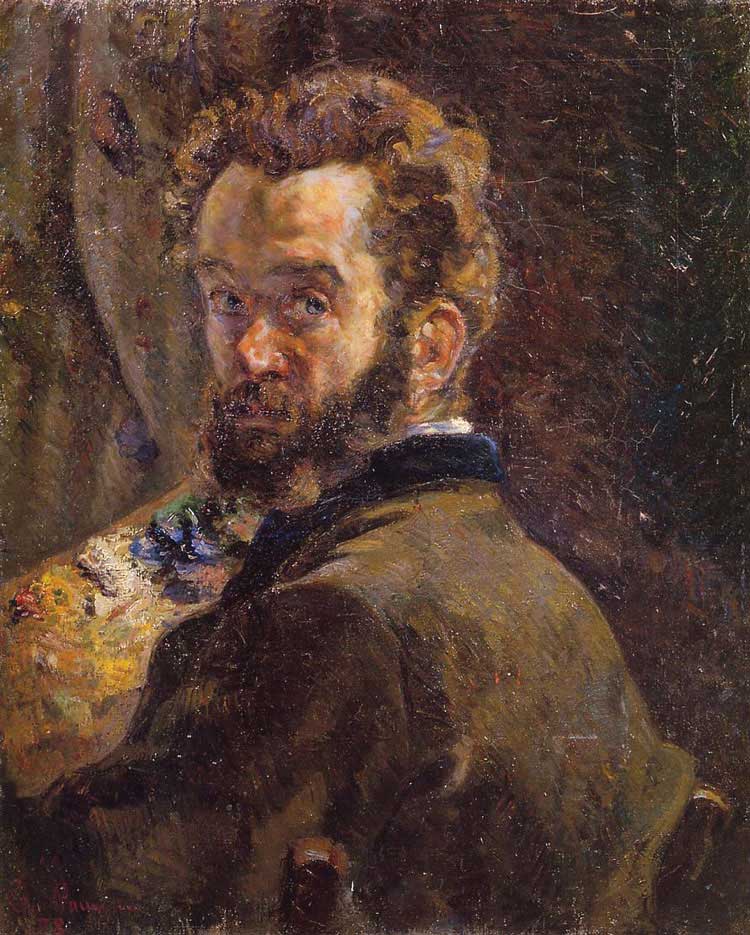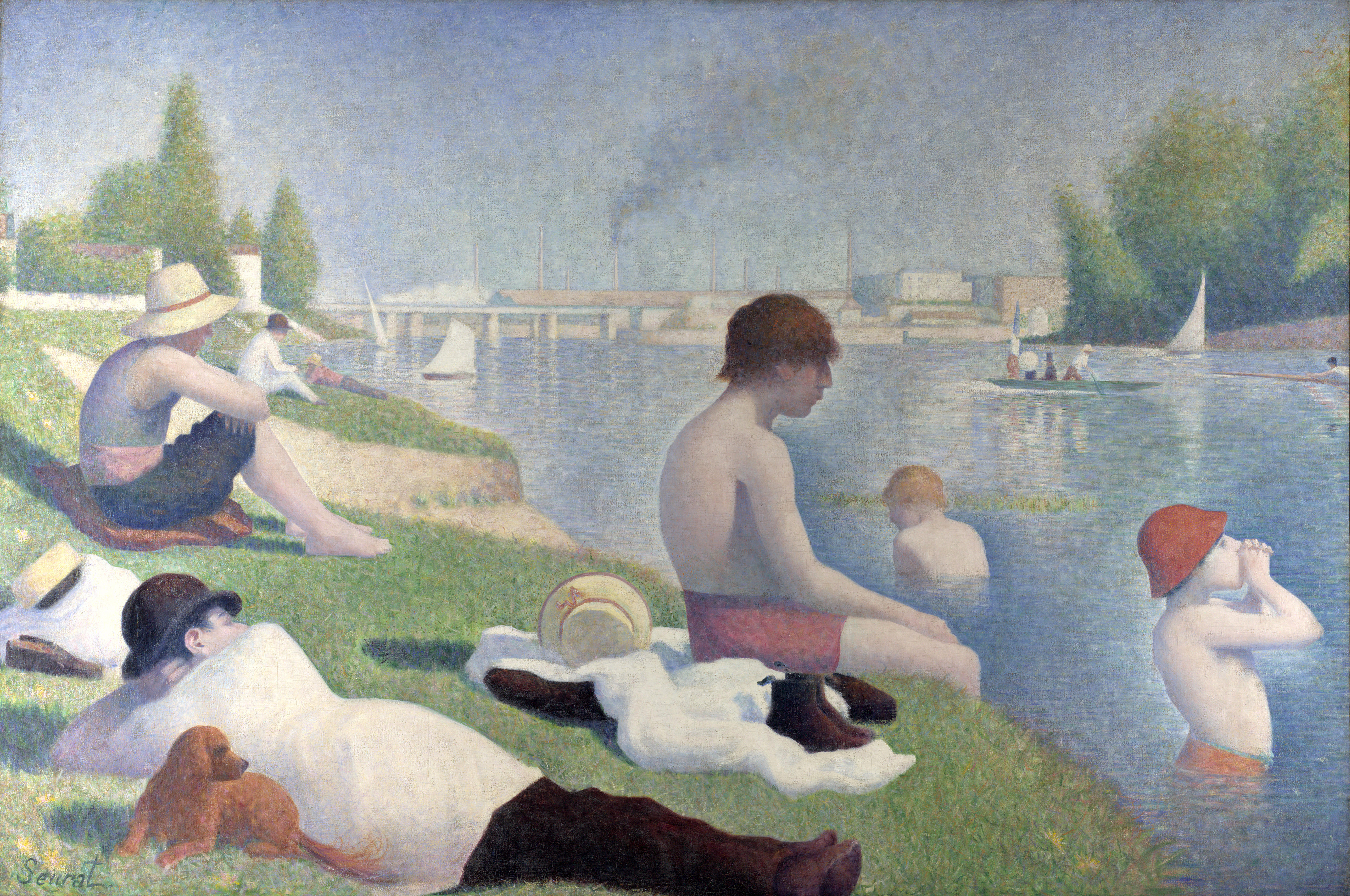|
Asnières (Van Gogh Series)
Asnières, now named Asnières-sur-Seine, is the subject and location of paintings that Vincent van Gogh made in 1887. The works, which include parks, restaurants, riverside settings and factories, mark a breakthrough in van Gogh's artistic development. In the Netherlands his work was shaped by great Dutch masters as well as Anton Mauve a Dutch realist painter who was a leading member of the Hague School and a significant early influence on his cousin-in-law van Gogh. In Paris van Gogh was exposed to and influenced by Impressionism, Symbolism, Pointillism, and Japanese woodblock print genres. During van Gogh's first twelve months in Paris he absorbed a lot of information about modern art from the best of the avant-garde artists of the time, but in practice his work in 1886 and early 1887 varied little from his paintings in the Netherlands. In the early 1887 he stayed with Émile Bernard and his parents in Asnières and the budding spring seemed to trigger an awakening within ... [...More Info...] [...Related Items...] OR: [Wikipedia] [Google] [Baidu] |
Vincent Van Gogh
Vincent Willem van Gogh (; 30 March 185329 July 1890) was a Dutch Post-Impressionist painter who posthumously became one of the most famous and influential figures in Western art history. In a decade, he created about 2,100 artworks, including around 860 oil paintings, most of which date from the last two years of his life. They include landscapes, still lifes, portraits and self-portraits, and are characterised by bold colours and dramatic, impulsive and expressive brushwork that contributed to the foundations of modern art. Not commercially successful, he struggled with severe depression and poverty, eventually leading to his suicide at age thirty-seven. Born into an upper-middle class family, Van Gogh drew as a child and was serious, quiet, and thoughtful. As a young man, he worked as an art dealer, often traveling, but became depressed after he was transferred to London. He turned to religion and spent time as a Protestant missionary in southern Belgium. He drif ... [...More Info...] [...Related Items...] OR: [Wikipedia] [Google] [Baidu] |
Émile Bernard (painter)
Émile Henri Bernard (28 April 1868 – 16 April 1941) was a French Post-Impressionist painter and writer, who had artistic friendships with Vincent van Gogh, Paul Gauguin and Eugène Boch, and at a later time, Paul Cézanne. Most of his notable work was accomplished at a young age, in the years 1886 through 1897. He is also associated with Cloisonnism and Synthetism, two late 19th-century art movements. Less known is Bernard's literary work, comprising plays, poetry, and art criticism as well as art historical statements that contain first-hand information on the crucial period of modern art to which Bernard had contributed. Biography Émile Henri Bernard was born in Lille, France, in 1868. As in his younger years his sister was sick, Émile was unable to receive much attention from his parents; he therefore stayed with his grandmother, who owned a laundry in Lille, employing more than twenty people. She was one of the greatest supporters of his art. The family moved to ... [...More Info...] [...Related Items...] OR: [Wikipedia] [Google] [Baidu] |
Self-portrait
A self-portrait is a representation of an artist that is drawn, painted, photographed, or sculpted by that artist. Although self-portraits have been made since the earliest times, it is not until the Early Renaissance in the mid-15th century that artists can be frequently identified depicting themselves as either the main subject, or as important characters in their work. With better and cheaper mirrors, and the advent of the panel portrait, many painters, sculptors and printmakers tried some form of self-portraiture. ''Portrait of a Man in a Turban'' by Jan van Eyck of 1433 may well be the earliest known panel self-portrait. He painted a separate portrait of his wife, and he belonged to the social group that had begun to commission portraits, already more common among wealthy Netherlanders than south of the Alps. The genre is venerable, but not until the Renaissance, with increased wealth and interest in the individual as a subject, did it become truly popular. [...More Info...] [...Related Items...] OR: [Wikipedia] [Google] [Baidu] |
Lucien Pissarro
Lucien Pissarro (20 February 1863 – 10 July 1944) was a landscape painter, printmaker, wood engraver and designer and printer of fine books. His landscape paintings employ techniques of Impressionism and Neo-Impressionism, but he also exhibited with Les XX. Apart from his landscapes he painted a few still lifes and family portraits. Until 1890 he worked in France, but thereafter was based in Britain. Biography Pissarro was born on 20 February 1863 in Paris. He was the oldest of seven children; the son of impressionism, Impressionist painter Camille Pissarro and his wife Julie (née Vellay). He studied with his father and—like his siblings Georges Henri Manzana Pissarro, Georges and Félix Pissarro, Félix—he spent his formative years surrounded by his father's fellow artists such as Claude Monet and Pierre-Auguste Renoir who frequented the Pissarro home. He was influenced by Georges Seurat and Paul Signac. In 1886, he exhibited at the last of the Impressionist exhibit ... [...More Info...] [...Related Items...] OR: [Wikipedia] [Google] [Baidu] |
Armand Guillaumin
Armand Guillaumin (; February 16, 1841 – June 26, 1927) was a French impressionist painter and lithographer. Biography Early years Born Jean-Baptiste Armand Guillaumin in Paris, he worked at his uncle's lingerie shop while attending evening drawing lessons. He also worked for a French government railway before studying at the Académie Suisse in 1861. There, he met Paul Cézanne and Camille Pissarro, with whom he maintained lifelong friendships. While he never achieved the stature of these two, his influence on their work was significant. With these two friends, Guillaumin exhibited at the Salon des Refusés in 1863.The three artists frequently painted in each other's company in the 1870s; for a time, Guillaumin and Cézanne had studios next door to each other on the Île Saint-Louis in Paris. In 1873, Cézanne made the only etchings of his career, one of them depicting Guillaumin (see Gallery below). Guillaumin was a member of the Société anonyme des artistes peintre ... [...More Info...] [...Related Items...] OR: [Wikipedia] [Google] [Baidu] |
Louis Anquetin
Louis Émile Anquetin (26 January 1861 – 19 August 1932) was a French painter. Biography Anquetin was born in Étrépagny, France, and educated at the Lycée Pierre Corneille in Rouen. In 1882 he came to Paris and began studying art at Léon Bonnat's studio, where he met Henri de Toulouse-Lautrec. The two artists later moved to the studio of Fernand Cormon, where they befriended Émile Bernard and Vincent van Gogh. Around 1887, Anquetin and Bernard developed a painting style that used flat regions of color and thick, black contour outlines. This style, named '' cloisonnism'' by critic Édouard Dujardin, was inspired by both stained glass and Japanese ukiyo-e. One example of this can be seen in ''Avenue de Clichy: Five O’Clock in the Evening'', argued by Dr. Bogomila Welsh-Ovcharov as being inspiration for Van Gogh's famous '' Cafe Terrace at Night''.Welsh-Ovcharov, Bogomila: ''Vincent van Gogh and the Birth of Cloisonism'' (!), Art Gallery of Ontario, Toronto, 24 Jan ... [...More Info...] [...Related Items...] OR: [Wikipedia] [Google] [Baidu] |
Paul Signac
Paul Victor Jules Signac ( , ; 11 November 1863 – 15 August 1935) was a French Neo-Impressionist painter who, working with Georges Seurat, helped develop the Pointillist style. Biography Paul Signac was born in Paris on 11 November 1863. He followed a course of training in architecture before, at the age of 18, deciding to pursue a career as a painter, after attending an exhibit of Monet's work. He sailed on the Mediterranean Sea, visiting the coasts of Europe and painting the landscapes he encountered. In later years, he also painted a series of watercolors of French harbor cities. In 1884 he met Claude Monet and Georges Seurat. He was struck by the systematic working methods of Seurat and by his theory of colors and he became Seurat's faithful supporter, friend, and heir with his description of Neo-Impressionism and Divisionism method. Under Seurat's influence he abandoned the short brushstrokes of Impressionism to experiment with scientifically-juxtaposed small d ... [...More Info...] [...Related Items...] OR: [Wikipedia] [Google] [Baidu] |
Georges Seurat
Georges Pierre Seurat ( , , ; 2 December 1859 – 29 March 1891) was a French post-Impressionist artist. He devised the painting techniques known as chromoluminarism and pointillism and used conté crayon for drawings on paper with a rough surface. Seurat's artistic personality combined qualities that are usually thought of as opposed and incompatible: on the one hand, his extreme and delicate sensibility, on the other, a passion for logical abstraction and an almost mathematical precision of mind. His large-scale work '' A Sunday Afternoon on the Island of La Grande Jatte'' (1884–1886) altered the direction of modern art by initiating Neo-Impressionism, and is one of the icons of late 19th-century painting. Biography Family and education Seurat was born on 2 December 1859 in Paris, at 60 rue de Bondy (now rue René Boulanger). The Seurat family moved to 136 boulevard de Magenta (now 110 boulevard de Magenta) in 1862 or 1863. Seurat: p. 16 His father, Antoine Chrysostom ... [...More Info...] [...Related Items...] OR: [Wikipedia] [Google] [Baidu] |
Auguste Renoir
Pierre-Auguste Renoir (; 25 February 1841 – 3 December 1919) was a French artist who was a leading painter in the development of the Impressionist style. As a celebrator of beauty and especially feminine sensuality, it has been said that "Renoir is the final representative of a tradition which runs directly from Rubens to Watteau." He was the father of actor Pierre Renoir (1885–1952), filmmaker Jean Renoir (1894–1979) and ceramic artist Claude Renoir (1901–1969). He was the grandfather of the filmmaker Claude Renoir (1913–1993), son of Pierre. Life Youth Pierre-Auguste Renoir was born in Limoges, Haute-Vienne, France, in 1841. His father, Léonard Renoir, was a tailor of modest means, so, in 1844, Renoir's family moved to Paris in search of more favorable prospects. The location of their home, in rue d’Argenteuil in central Paris, placed Renoir in proximity to the Louvre. Although the young Renoir had a natural proclivity for drawing, he exhibited a greater ta ... [...More Info...] [...Related Items...] OR: [Wikipedia] [Google] [Baidu] |
Claude Monet
Oscar-Claude Monet (, , ; 14 November 1840 – 5 December 1926) was a French painter and founder of impressionist painting who is seen as a key precursor to modernism, especially in his attempts to paint nature as he perceived it. During his long career, he was the most consistent and prolific practitioner of impressionism's philosophy of expressing one's perceptions before nature, especially as applied to '' plein air'' (outdoor) landscape painting. The term "Impressionism" is derived from the title of his painting '' Impression, soleil levant'', exhibited in the 1874 ("exhibition of rejects") initiated by Monet and his associates as an alternative to the Salon. Monet was raised in Le Havre, Normandy, and became interested in the outdoors and drawing from an early age. Although his mother, Louise-Justine Aubrée Monet, supported his ambitions to be a painter, his father, Claude-Adolphe, disapproved and wanted him to pursue a career in business. He was very close to his m ... [...More Info...] [...Related Items...] OR: [Wikipedia] [Google] [Baidu] |
Edgar Degas
Edgar Degas (, ; born Hilaire-Germain-Edgar De Gas, ; 19 July 183427 September 1917) was a French Impressionist artist famous for his pastel drawings and oil paintings. Degas also produced bronze sculptures, prints and drawings. Degas is especially identified with the subject of dance; more than half of his works depict dancers. Although Degas is regarded as one of the founders of Impressionism, he rejected the term, preferring to be called a realist,Gordon and Forge 1988, p. 31 and did not paint outdoors as many Impressionists did. Degas was a superb draftsman, and particularly masterly in depicting movement, as can be seen in his rendition of dancers and bathing female nudes. In addition to ballet dancers and bathing women, Degas painted racehorses and racing jockeys, as well as portraits. His portraits are notable for their psychological complexity and their portrayal of human isolation. At the beginning of his career, Degas wanted to be a history painter, a calling f ... [...More Info...] [...Related Items...] OR: [Wikipedia] [Google] [Baidu] |
Montmartre
Montmartre ( , ) is a large hill in Paris's northern 18th arrondissement. It is high and gives its name to the surrounding district, part of the Right Bank. The historic district established by the City of Paris in 1995 is bordered by Rue Caulaincourt and Rue Custine on the north, the Rue de Clignancourt on the east and the Boulevard de Clichy and Boulevard de Rochechouart to the south, containing . Montmartre is primarily known for its artistic history, the white-domed Basilica of the Sacré-Cœur on its summit, as well as a nightclub district. The other church on the hill, Saint Pierre de Montmartre, built in 1147, was the church of the prestigious Montmartre Abbey. On 15 August 1534, Saint Ignatius of Loyola, Saint Francis Xavier and five other companions bound themselves by vows in the Martyrium of Saint Denis, 11 Rue Yvonne Le Tac, the first step in the creation of the Jesuits. Near the end of the 19th century and at the beginning of the 20th, during the Belle Époq ... [...More Info...] [...Related Items...] OR: [Wikipedia] [Google] [Baidu] |









.jpg)
